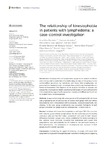Mostrar o rexistro simple do ítem
The relationship of kinesiophobia in patients with lymphedema: a case-control investigation
| dc.contributor.author | Labra, Carmen de | |
| dc.contributor.author | Monteiro, Ana Julia | |
| dc.contributor.author | Losa Iglesias, Marta Elena | |
| dc.contributor.author | Dias, Adriano | |
| dc.contributor.author | Becerro-de-Bengoa-Vallejo, Ricardo | |
| dc.contributor.author | Silva-Migueis, Helena | |
| dc.contributor.author | Macedo, Filipe | |
| dc.contributor.author | López-López, Daniel | |
| dc.contributor.author | Gómez Salgado, Juan | |
| dc.date.accessioned | 2024-04-19T08:33:54Z | |
| dc.date.available | 2024-04-19T08:33:54Z | |
| dc.date.issued | 2024-02 | |
| dc.identifier.citation | Monteiro AJ, de Labra C, Losa-Iglesias ME, Dias A, Becerro-de-Bengoa-Vallejo R, Silva-Migueis H, Macedo F, López-López D and Gómez-Salgado J (2024) The relationship of kinesiophobia in patients with lymphedema: a case-control investigation. Front. Psychiatry 15:1293614. doi: 10.3389/fpsyt.2024.1293614 | es_ES |
| dc.identifier.uri | http://hdl.handle.net/2183/36255 | |
| dc.description.abstract | [Abstract] Kinesiophobia and lymphedema appear to be related conditions, and it is important to understand this relationship, as many of the symptoms and comorbidities presented by individuals with lower limb lymphedema are prevented and treated through movement, thus constituting kinesiophobia as a barrier to intervention. The objective of this study is, therefore, to evaluate and analyze the kinesiophobic beliefs reported by individuals with and without lower limb lymphedema, regarding the agreement, severity and differences found, and to establish levels of kinesiophobia. Methods: A case-control study with a total sample of 80 participants (40 with lower limb lymphedema and 40 without) was performed. Both groups (with and without lymphedema) were characterized anthropologically, sociodemographically, and clinically. In the case group, lymphedema was evaluated. Participants in both groups completed the Tampa Scale for Kinesiophobia - 13 items (TSK-13). Results: Individuals with lower limb lymphedema had higher TSK-13 scores than their matched group without lymphedema. The items belonging to the activity avoidance subscale had the highest agreement and score in both groups. Differences between groups were mainly established for items belonging to the somatic focus subscale, showing that individuals with lower limb lymphedema have kinesiophobic beliefs related to the perceived severity of their lymphedema. The prevalence of kinesiophobia was increased in both groups, but the severity was mild. Conclusions: Considering the apparent tendency of people with lower limb lymphedema to present kinesiophobia and movement-limiting beliefs regarding the condition, greater attention should be paid to its assessment, prevention and treatment from a multidisciplinary and multimodal perspective, which takes into account the multiplicity of factors inherent to kinesiophobia and lymphedema and thus reduce their impact on the management of lymphedema. | es_ES |
| dc.language.iso | eng | es_ES |
| dc.publisher | Frontiers | es_ES |
| dc.relation.uri | https://doi.org/10.3389/fpsyt.2024.1293614 | es_ES |
| dc.rights | Atribución-NoComercial-SinDerivadas 3.0 España | es_ES |
| dc.rights.uri | http://creativecommons.org/licenses/by-nc-nd/3.0/es/ | * |
| dc.subject | Lower limb lymphedema | es_ES |
| dc.subject | Fear of movement | es_ES |
| dc.subject | Beliefs | es_ES |
| dc.subject | Activity avoidance | es_ES |
| dc.subject | Tampa scale for kinesiophobia | es_ES |
| dc.subject | Somatic focus | es_ES |
| dc.title | The relationship of kinesiophobia in patients with lymphedema: a case-control investigation | es_ES |
| dc.type | info:eu-repo/semantics/article | es_ES |
| dc.rights.access | info:eu-repo/semantics/openAccess | es_ES |
| UDC.journalTitle | Frontiers in Psychiatry | es_ES |
| UDC.volume | 15 | es_ES |
| UDC.startPage | 1293614 | es_ES |
| UDC.coleccion | Investigación | es_ES |
| UDC.departamento | Ciencias da Saúde | es_ES |
| UDC.grupoInv | Grupo de Investigación Saúde e Podoloxía (GISAP) | es_ES |
Ficheiros no ítem
Este ítem aparece na(s) seguinte(s) colección(s)
-
Investigación (FEP) [498]






